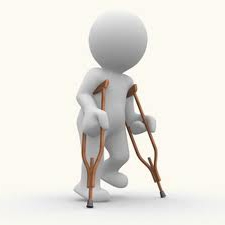In Art. 2 of the Constitution, the obligation of the state to recognize, protect and respect freedoms and human rights is enshrined. The main means of realizing this task are preventive measures, disciplinary, criminal and administrative liability, as well as compensation for harm to health. 
Commitment Categories
Civil law distinguishes between non-contractual and contractual interactions. In accordance with this, obligations are also established. Contractual aimed at regulating normal economic relations. But with the interaction of people, enterprises and other entities with intangible personal and property benefits, damage can be caused. It can be caused by accident, intentionally, due to a mistake or as a result of force majeure of nature. In the event of situations in which a person has been injured (injured) or died, obligations appear that provide for compensation for harm to life and health. They have some features. Next, we will consider how the compensation of harm caused to the health of a citizen is carried out.
General information
The legislation provides for the following insurance events in which compensation is made for harm caused to health. They are recorded in article 1084 of the Civil Code. These include, but are not limited to:
- Damage caused in the performance of obligations under a contract.
- Personal injury or death while serving in ATS.
- Military trauma.
Compensation for harm to health is carried out in accordance with the rules that are provided for in Sec. 59 of the Civil Code, if a contract or law does not provide for a higher amount of liability.
Essence of obligations
As such, there is no definition of liability for harm in the law. Nevertheless, the basic idea of such an obligation is present in Art. 1064, p. 1 of the Civil Code. In accordance with this provision, damage that is caused to property or person, to a citizen or organization, in full is subject to compensation. The person responsible is the person responsible for the accident. The main circumstance, which is laid down in this norm, is the establishment of liability, expressed in the obligation of the person who caused the harm to compensate him.  There is no direct mention of the injured party in the law. However, it becomes clear that the victim has the right to demand compensation. Thus, this legal relationship acts as a binding.
There is no direct mention of the injured party in the law. However, it becomes clear that the victim has the right to demand compensation. Thus, this legal relationship acts as a binding.
Correlation of concepts
In legal publications, definitions such as “liability for harm” and “liability for damage” are often used as identical. Moreover, the second concept acts as the main one. Responsibility in civil matters provides for the application of certain coercive measures to the violator. They are presented in the form of sanctions having property content. This provision applies to both non-contractual and contractual liability. However, the latter has a secondary character. It accompanies the obligation in some way, taking effect only in case of violation.
If it was executed in accordance with the conditions, then responsibility does not manifest itself. The situation with the question of causing harm is different. In this case, the obligation appears upon violation.Since its inception, it has a responsibility in its content - the ability to apply sanctions to the violator. Therefore, it does not accompany or supplement any obligation. The violator is liable for damage caused through his fault in the form of compensation, if the conditions for this are provided by law. In the literature, according to the tradition proceeding from Roman law, it is called tort.
Subjects
Based on the foregoing, it is possible to determine the following: an obligation arising from the infliction of harm is such a civil relationship in which the victim may demand full compensation for the damage from the guilty party (causer).  The way to exercise this right is the restoration of the property state of the victim in kind or monetary compensation for losses. In accordance with the definition, the subjective composition of these relations becomes clear. The victim acts as a creditor, and the causer as a debtor. The duty of the latter is to satisfy the requirements of the victim.
The way to exercise this right is the restoration of the property state of the victim in kind or monetary compensation for losses. In accordance with the definition, the subjective composition of these relations becomes clear. The victim acts as a creditor, and the causer as a debtor. The duty of the latter is to satisfy the requirements of the victim.
Regulation Features
Compensation for health damage in Russian legislation stands out as a special tort. Its regulation along with the provisions of the Civil Code is also carried out through special legal acts. Among them, the Rules previously held a special place, in accordance with which the compensation for harm caused to the health of an employee by an occupational disease, injury or other damage to his condition related to the performance of his duties was carried out.
Today, this normative act is no longer valid. Currently, the current document on the basis of which compensation is made for the health of an employee is the Federal Law "On Compulsory Social Insurance against Occupational Accidents and Occupational Diseases."
Responsibility
Due to the fact that the health and life of citizens are recognized as the highest values, any damage to them and, moreover, the death of a person are considered illegal. Damage in this case acts as a restriction of non-property (personal) goods. This in itself allows a person to demand compensation and compensation for moral harm to health. The main object of liability in this case is property losses arising from injury or death. They, in particular, are expressed in the loss of earnings and other income, in the costs of restoration of the state, burial, etc.
Specificity of causation
One of the main features that compensation for health has is the need to establish not one, but two causal relationships. The first should appear between inaction or the action of the perpetrator and directly by injury or death. The second connection should be seen between the damage that was caused to the victim, and property losses. 
Classification
Compensation shall be established in accordance with the category of benefits to which the harm has been caused. So, allocate responsibility:
- For damage resulting from the death of a breadwinner.
- For harm caused by injury (damage) to health.
These cases differ in the nature and extent of responsibility, subjective composition and other signs and circumstances. In case of damage to health, one option is allowed - this is the recovery from the person who caused him losses in the form of earnings that the victim lost, and expenses incurred by him additionally. In this regard, if the doctor who is guilty wishes to cure the victim, the court must recognize this only if there is a clear consent of the patient. Compensation for harm to minors is established by Art. 1087 Civil Code.
Payouts
In the event of death, the person responsible for this is liable in the form of compensation to those who have lost the source of funds due to this fact.Assignment of the amount of payments is carried out in accordance with the share of earnings of the deceased, which he could receive or received for his maintenance before the accident. The amount of compensation can be changed in the future. For example, in case of harm to life and health, the guilty person has the right to raise the question of reducing compensation if his financial situation worsens. This can happen due to disability or reaching retirement age, which deprives him of the opportunity to earn enough money to provide compensation for harm to the victim’s health and his own maintenance.  However, with intentional damage to the victim, the perpetrator loses this opportunity. Health damage compensation indexation is carried out in accordance with the cost of living.
However, with intentional damage to the victim, the perpetrator loses this opportunity. Health damage compensation indexation is carried out in accordance with the cost of living.
Special cases
If the victim suffered harm through his own gross negligence, the amount of compensation is reduced depending on the amount of fault of each of the participants. This procedure is established by Art. 1083, paragraph 2 of the Civil Code. This proportionality is especially relevant when compensation for health damage is prescribed in an accident. In particular, in practice, there are quite frequent cases when the driver commits pedestrian collision, being drunk. In such circumstances, the motorist does not get rid of responsibility. However, its size is reduced. In this regard, the claim for damages to health will be partially satisfied in court.
Consumer Rights Protection
An application for damages to health due to prescription, structural and other shortcomings of a service, work or product may be filed with a court. This opportunity is highlighted in the form of a special tort in the legislation. The procedure in accordance with which compensation is paid and compensation for moral harm to health is established by the Federal Law on the Protection of Consumer Rights.
Injured party with loss of breadwinner
Property losses in the event of the death of a person who is a source of income arise for his relatives, whom he fully or partially maintained during his lifetime, as well as for everyone who incurred the costs of his funeral. These entities include:
- Dependents of the deceased, disabled according to age (men from 60 and women from 55 years old, minor children) or due to disability. They include, among others, those who, at the time of his death, had the right to receive content from him, although he might not have received it in fact.
- Other (able-bodied) dependents who became incapable of work within five years after the death of the breadwinner. They may, for example, be the mother or wife of the deceased who have reached retirement age during the specified period.
- A child born after the death of a breadwinner.
- One of the relatives of the deceased (spouse or parent), regardless of ability to work, who is caring for minors (under 14 years of age) who were dependent on the victim, or for sisters, grandchildren, brothers, children and others who need outside care due to their health condition ( regardless of age).

In accordance with the legislation, the above categories are subject to compensation. Payments are made within the time limits provided for in Art. 1088, paragraph 2 of the Civil Code. In particular, for people with disabilities - for the period of disability, men over 60 and women over 55 years old - for life, students - until graduation, but not longer than 23 years old, minors - up to 18 liters.
Payout calculation
As mentioned above, the amount of compensation for each is set in accordance with the share of earnings that they received or could receive during the life of the deceased, minus his own part. So, in the case of two persons entitled to payment - a wife and a child of 3 years and an average salary of 15,000, the payment for each will be 15,000: 3 = 5,000 rubles.At the same time, the proportion of able-bodied relatives who do not have the right to compensation, but who received part of his income during the life of the deceased, is also taken into account. So, if we consider the example already given, adding an adult able-bodied daughter to the family, the amount of payments to the youngest child and wife will be: 15,000: 4 = 3,750 rubles. If the victim had persons who were not dependent on him, but who had the right to receive maintenance from him (for example, an elderly mother living separately), the amount that falls on them is deducted from the total income of the deceased. The remainder is divided by the number of dependents. The amount of compensation does not include pensions that are assigned to relatives both after and before his death, their earnings, scholarships, etc.
Compulsory insurance
By law or contract, an increase in the established amount of compensation is allowed. Such conditions may be present, for example, in a labor agreement concluded during the life of the deceased. In accordance with previous legislation, such obligations were prescribed in the collective agreement. Today, the Federal Law on compulsory social insurance against occupational diseases and industrial accidents applies. It spelled out fundamentally new conditions for compensation for harm to employees. In this case, it is carried out by the insured. Despite the fact that the essence of the calculation has not changed, the employer and employee are no longer able to increase the amount of compensation, since it is established by law in the framework of compulsory social insurance programs. 
Counterterrorism
The Legislation has been approved in accordance with the Rules, in accordance with which compensation is made to persons performing official duties. These provisions regulate the payment of benefits directly to the victims themselves or, in the event of their death, to dependent persons, compensation for harm in the form of a lump sum compensation. There are also rules governing monthly payments in case of damage caused by radiation exposure during the Chernobyl accident, which led to the loss of performance regardless of degree (without establishing disability).
Burial expenses
The person who caused the death of the victim is obliged to reimburse the costs of the funeral of the deceased. They include the costs of direct burial, the erection of a monument and a fence standard for a particular area, as well as the holding of commemoration within reasonable limits. In Federal Law No. 8, Article 9, a list of expenses that are reimbursed by the state is determined. Costs in excess of those established by law are compensated by the perpetrators. Their size is determined in accordance with general burial standards. The fault of the victim in such cases is not taken into account.
